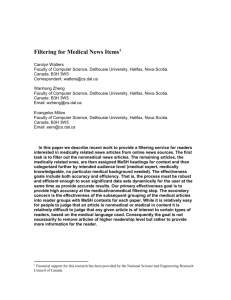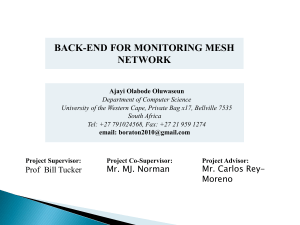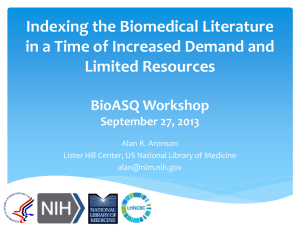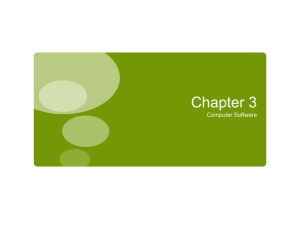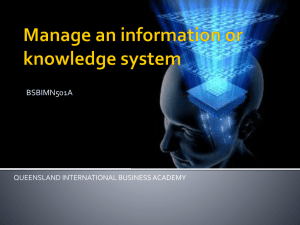presentation
advertisement
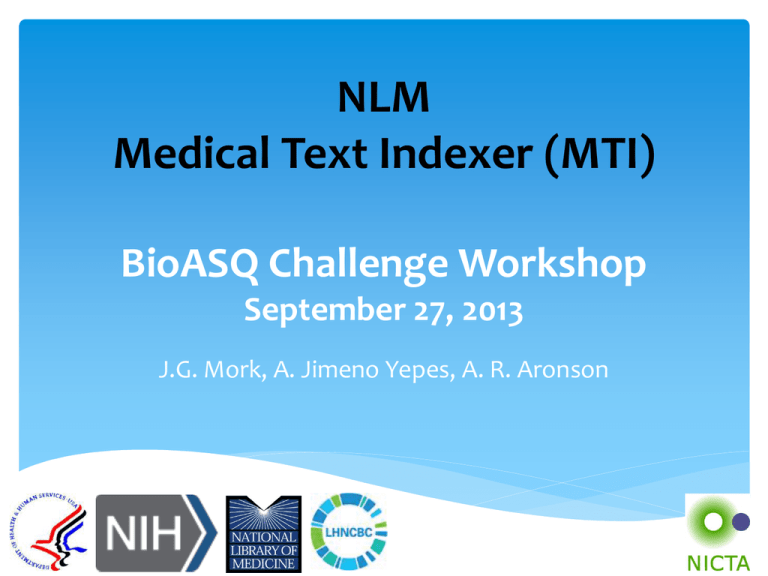
NLM Medical Text Indexer (MTI) BioASQ Challenge Workshop September 27, 2013 J.G. Mork, A. Jimeno Yepes, A. R. Aronson Disclaimer The views and opinions expressed do not necessarily state or reflect those of the U.S. Government, and they may not be used for advertising or product endorsement purposes. 2 Outline MTI Overview Description Performance Future Work Questions 3 MTI - Overview Summarizes input text into an ordered list of MeSH Headings The weathervane. (23463855) In use since mid-2002 (Indexers, Cataloging, HMD) Before 911... (23465427) MTI as First-Line Indexer (MTIFL) since February 2011 The in-betweeners. (23348431) Developed with continued Index(23143314) Section collaboration Valete, salvete. Uses article Title and Abstract Provides recommendations for 93% of indexed articles (2012) 4 MTI MetaMap Indexing Actually found in text Restrict to MeSH Maps UMLS Concepts to MeSH PubMed Related Citations Not necessarily found in text 5 Unified Medical Language System (UMLS) Large multi-lingual biomedical vocabulary database UMLS Metathesaurus (currently using 2012AB) MetaMap Indexing uses a subset: Only requires UMLS license and for use with US-based projects 2,461,504 concepts with 7,685,881 entries English Only 75 of the 168 Source Vocabularies Changes twice a year 6 MetaMap Indexing (MMI) Used for finding UMLS concepts actually in the text. Better coverage versus just looking for MeSH Headings Provides our best indicator of MeSH Headings Handles spelling variants, abbreviations, and synonym identification. (Handles most British Spellings) Obstructive Sleep Apnea Obstructive Sleep Apnoea OSA (3-ways ambiguous) * Heart Attack * Myocardial Infarction 7 Restrict to MeSH Encephalitis Virus, California ET: Jamestown Canyon virus ET: Tahyna virus Inkoo virus Jerry Slough Allows us to map UMLS concepts to virus MeSH Headings Keystone virus Updated with each UMLSMelao release virus San Angelo virus Extends MMI abilities by mapping nomenclature to MeSH Serra do Navio virus Snowshoe hare virus Trivittatus virus Lumbo virus South River virus ET: California Group Viruses 8 PubMed Related Citations 9 PubMed Related Citations (PRC) Uses PubMed pre-calculated related articles Only use MeSH Headings, no Check Tags, no Subheadings, no Supplementary Concepts Provides terms not available in title/abstract Used to filter and support MeSH Headings identified by MetaMap Indexing Can provide non-related terms, so heavily filtered 10 Special Handling Forcing Recommendations New MeSH Headings (first 6 – 12 months) Correct: 66.96% (2,935 / 4,383) “B” (Organisms) and “D” (Chemicals and Drugs) in title Correct: 69.90% (77,882 / 111,416) Most MeSH Headings and Supplementary Concepts in title Correct: 81.18% (377,571 /465,128) 11 Special Handling Forcing Recommendations (continued) Check Tag Triggers (~3,000 + 770 Tree Rules) “fetal heart rate” Female and Pregnancy Correct: 81.69% (885,092 / 1,083,457) 496 Triggers – all from Indexer Feedback “saxs” X-Ray Diffraction + Scattering, Small Angle Correct: 65.07% (73,692 / 113,257) 12 MTI Example MTI as First Line Indexer (MTIFL) 89 Journals currently in MTIFL program – 327 by end of 2015 Heuristic #7: #6: PRC MMIOnly OnlyTerm Term MTI & MTIFL philosophically different If MMI both does MMI & not PRC have recommend a more general a Almost 30term rules/heuristics used remove more related, specific remove term, the term. the term. Special Filtering using MMI & PRC against each other MMI tends to provide more general terms PRC tends to provide more specific terms (or terms not related) Smaller more accurate list of terms than MTI 14 Performance Fruition of 2011 Changes Focus on Precision versus Recall 15 Future Work Structured Abstracts Full Text Author Supplied Keywords Improving Subheading Attachment Expanding MTIFL Program Assisting on Gene and Chemical Identification Projects Recommending some Publication Types Species Detection and Filtering 16 Questions? MTI Team Members: Alan (Lan) R. Aronson: alan@nlm.nih.gov James G. Mork: mork@nlm.nih.gov Antonio J. Jimeno Yepes: antonio.jimeno@gmail.com Web Site: http://ii.nlm.nih.gov 17 Extensible Same program, five levels of filtering, customized output All Processing – Base Filtering Indexing – High Recall Filtering Cataloging – High Recall Filtering History of Medicine – High Recall Filtering MTIFL – Balanced Recall/Precision Filtering Strict – High Precision Filtering (not currently used) Ability to Turn Off All Filtering (used in experiments) 18 Data Creation & Management System (DCMS) 19 Challenges MTI Currently Not Able to Differentiate: Species specific terms BIRC3 protein, human Birc3 protein, mouse Birc3 protein, rat Concepts where words are separated by text “Lon is an oligomeric ATP-dependent protease” in text should recommend Lon Protease (ET for Protease La) 20 Performance Current YTD (November 2012 – August 2013) Percentage Right (Precision) MTI MTIFL Citations 539,157 6,846 MMI Only 69.18% / 1,313,077 76.61% / 11,536 PRC Only 42.98% / 509,775 80.03% / 3,839 MMI+PRC 54.93% / 1,837,432 72.04% / 30,075 56.93% 73.78% Overall 21




